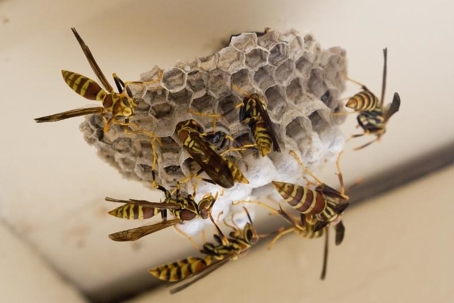Wasp Nests
A wasp nest is the dwelling place constructed by social wasps, such as yellowjackets and hornets, to house their colony. These nests are typically made from a papery substance, which the wasps create by chewing wood fibers and mixing them with saliva. This papery material forms the outer structure of the nest, providing protection and insulation for the wasp colony.
What Do Wasp Nests Look Like?
Wasp nests vary in appearance depending on the species, but they generally share certain characteristics that make them identifiable. Wasp nests are usually papery, layered structures made from chewed wood fibers mixed with the wasp’s saliva. This gives them a grayish or light brown color and a papery texture, similar to rough cardboard. The surface often has a swirled, layered look, resembling thin paper mache.
Common Types of Wasp Nests
Paper Wasp Nests
Shape: Open, umbrella-shaped nest with exposed hexagonal cells.
Size: Typically 3–8 inches across but can grow larger.
Color: Gray to brownish paper-like color.
Texture: Smooth and thin layers of paper-like material.
Location: Commonly found under eaves, porch ceilings, window frames, deck railings, and tree branches.
Distinct Feature: The comb (cells) is visible from underneath—there is no outer covering.
Yellow Jacket Nests
Shape: Enclosed, ball-shaped or oval structure with a single entrance hole.
Size: Can range from softball-sized to basketball-sized, sometimes larger.
Color: Gray, tan, or brown.
Texture: Papery with layered, swirling patterns.
Location: Typically found underground, in wall voids, attics, or bushes.
Distinct Feature: A completely enclosed structure—unlike paper wasps’ open nests.
Hornet Nests (e.g., Bald-Faced Hornet)
Shape: Large, enclosed oval or teardrop-shaped nest with a small bottom entrance.
Size: Commonly 12–24 inches tall and up to 18 inches wide.
Color: Grayish, often with distinct swirling patterns.
Texture: Smooth outer paper layers.
Location: Usually high up in trees, on building overhangs, or in shrubs.
Distinct Feature: A large, fully enclosed nest hanging from a single stalk.
How to Identify Active Nests
Visible wasp activity: Wasps flying in and out frequently.
Buzzing sounds: Especially from enclosed nests in walls or attics.
Fresh paper layers: A sign that wasps are still expanding the nest.
Never disturb or knock down a wasp nest, especially if it’s active. Wasps are highly defensive and can sting multiple times. Our professional pest control services have the proper gear and insecticides to remove or relocate nests safely.
Where Are Wasp Nests Found?
Wasp nests can appear in a wide range of locations, but they tend to favor quiet, sheltered, and undisturbed spots near a source of food, water, and building materials (like wood fibers). The exact nesting site depends on the species of wasp, but below is a detailed, professional breakdown of the most common places you’ll find them — both outdoors and indoors.
Outdoor Locations
Under Eaves and Roof Overhangs
Why: Offers protection from rain, wind, and predators.
Common Species: Paper wasps and hornets.
What to Look For: Small umbrella-shaped nests or enclosed gray paper balls hanging from a single stalk.
Tree Branches and Shrubs
Why: Provides elevation, concealment, and structural support.
Common Species: Bald-faced hornets.
What to Look For: Large, football-shaped paper nests often hanging several feet off the ground.
Decks, Porches, and Railings
Why: Offers shade, structure, and proximity to human activity (where food sources abound).
Common Species: Paper wasps.
What to Look For: Flat, open nests with visible cells attached to the underside of boards or beams.
Underground or Ground Cavities
Why: Natural insulation and protection from predators.
Common Species: Yellow jackets.
What to Look For: Small holes in the ground (often abandoned rodent burrows) with steady wasp traffic entering and exiting. Avoid mowing or disturbing these areas.
Fences, Mailboxes, and Outdoor Equipment
Why: Provides structural stability and easy access to food sources.
Common Species: Paper wasps.
What to Look For: Small nests tucked into hidden corners or hollow spaces.
Attics, Sheds, and Garages (Entry from Outside)
Why: Warmth, protection, and limited disturbance.
Common Species: Yellow jackets and Paper wasps.
What to Look For: Paper-like nests in rafters, behind insulation, or near vents.
Indoor and Structural Locations
Wall Voids and Ceiling Cavities
Why: Hidden and warm, ideal for yellow jackets.
Signs: Persistent buzzing behind drywall, wasps entering through cracks, gaps, or vents.
Attics and Crawl Spaces
Why: Protected, dry, and warm environment.
Signs: Papery nests on rafters, or wasps clustering near light or ventilation openings.
Vents, Chimneys, and Soffits
Why: Provide easy access from outdoors and secure shelter inside the structure.
Signs: Wasps flying in and out of small openings near the roofline or air vents.
Seasonal Nesting Patterns
Spring: Queens emerge from hibernation and start small nests in sheltered spots.
Summer: Nests grow rapidly; colonies are most active and aggressive.
Fall: Colonies reach full size, and wasps become more defensive.
Winter: Most nests die off; only queens survive, hibernating in cracks or crevices until spring.
If you find more than a few wasps frequenting a single area, there’s likely a nest nearby—even if it’s hidden. Our professional pest control technicians use protective gear, residual insecticides, and safety-oriented removal techniques to eliminate nests safely, minimizing risk of stings or re-infestation.

